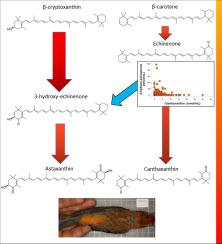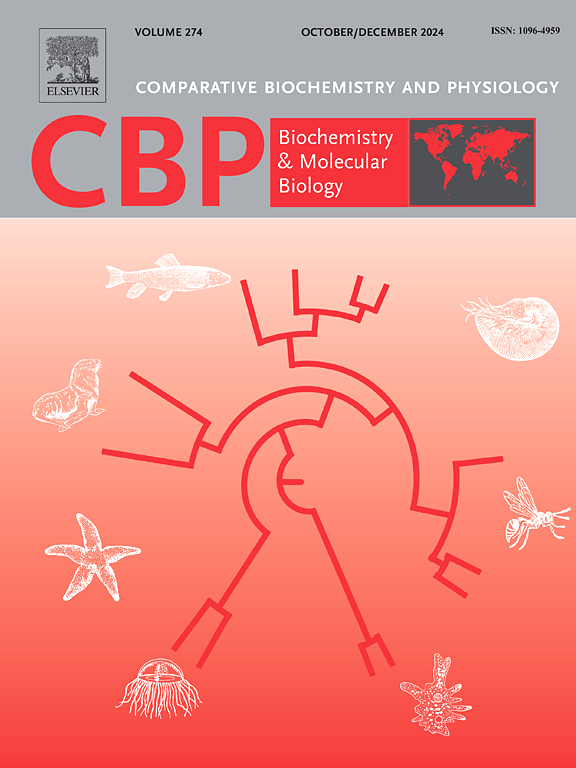类胡萝卜素转化的替代途径会影响色彩生产效率吗?对野生鹖鸟(Loxia curvirostra)的相关研究。
IF 1.8
3区 生物学
Q4 BIOCHEMISTRY & MOLECULAR BIOLOGY
Comparative Biochemistry and Physiology B-Biochemistry & Molecular Biology
Pub Date : 2024-09-13
DOI:10.1016/j.cbpb.2024.111032
引用次数: 0
摘要
在许多脊椎动物中,食物中的黄色类胡萝卜素通过酶促作用转化为 4C 酮类胡萝卜素色素,从而形成明显的红色。在性选择的作用下,这些色素可能会作为个体质量的信号而进化。要作为信号进化,它们必须传递可靠的信息,使接收者和发出者都受益。有人认为,个体质量与线粒体代谢之间的紧密联系确保了基于 4C 酮类胡萝卜素的着色的可靠性,而线粒体代谢据说参与了黄色类胡萝卜素的转化。我们研究了大量(n > 140)野生雄性鹖(Loxia curvirostra)羽毛和血浆中一系列类胡萝卜素的共存情况。羽毛变红的主要原因是 3-hydroxy-echinenone (3HOE)。另外两种含量较少的红色 4C 酮类胡萝卜素(虾青素和角虾青素)可能是造成羽毛颜色的原因,因为它们是较红的色素。这一点在虾青素上得到了证实,但在角黄素上没有得到证实,因为角黄素的含量与羽毛的颜色明显无关。此外,换羽的鹖鸟血液中的3HOE和虾青素含量高于未换羽的鹖鸟,而角黄素则没有差异。角黄素和 3HOE 可以由棘烯酮生成,棘烯酮可能是食物中 β-胡萝卜素酮化的产物。因此,棘烯酮可通过酮化或羟化作用分别生成角黄素或 3HOE 。在换羽的鸟类中,3HOE的血液水平与其产物虾青素呈正相关,但与角黄素的水平呈负相关。红嘴鹖的血浆角黄素含量也较低。羟化作用相对于酮化作用的减少可以解释角黄素的产生。我们推测,红色表明鸟类有能力避免在复杂的酶解途径中出现低效偏差。本文章由计算机程序翻译,如有差异,请以英文原文为准。

Could alternative pathways for carotenoid transformation affect colour production efficiency? A correlative study in wild common crossbills (Loxia curvirostra)
In many vertebrates, dietary yellow carotenoids are enzymatically transformed into 4C-ketocarotenoid pigments, leading to conspicuous red colourations. These colourations may evolve as signals of individual quality under sexual selection. To evolve as signals, they must transmit reliable information benefiting both the receiver and the signaler. Some argue that the reliability of 4C-ketocarotenoid-based colourations is ensured by the tight link between individual quality and mitochondrial metabolism, which is supposedly involved in transforming yellow carotenoids. We studied how a range of carotenoids covary in the feathers and blood plasma of a large number (n > 140) of wild male common crossbills (Loxia curvirostra). Plumage redness was mainly due to 3-hydroxy-echinenone (3HOE). Two other, less abundant, red 4C-ketocarotenoids (astaxanthin and canthaxanthin) could have contributed to feather colour as they are redder pigments. This was demonstrated for astaxanthin but not canthaxanthin, whose feather levels were clearly uncorrelated to colouration. Moreover, moulting crossbills carried more 3HOE and astaxanthin in blood than non-moulting ones, whereas canthaxanthin did not differ. Canthaxanthin and 3HOE can be formed from echinenone, a probable product of dietary β-carotene ketolation. Echinenone could thus be ketolated or hydroxylated to produce canthaxanthin or 3HOE, respectively. In moulting birds, 3HOE blood levels positively correlated to astaxanthin, its product, but negatively to canthaxanthin levels. Redder crossbills also had lower plasma canthaxanthin values. A decrease in hydroxylation relative to ketolation could explain canthaxanthin production. We hypothesize that red colouration could indicate birds' ability to avoid inefficient deviations within the complex enzymatic pathways.
求助全文
通过发布文献求助,成功后即可免费获取论文全文。
去求助
来源期刊
CiteScore
4.60
自引率
4.50%
发文量
77
审稿时长
22 days
期刊介绍:
Comparative Biochemistry & Physiology (CBP) publishes papers in comparative, environmental and evolutionary physiology.
Part B: Biochemical and Molecular Biology (CBPB), focuses on biochemical physiology, primarily bioenergetics/energy metabolism, cell biology, cellular stress responses, enzymology, intermediary metabolism, macromolecular structure and function, gene regulation, evolutionary genetics. Most studies focus on biochemical or molecular analyses that have clear ramifications for physiological processes.

 求助内容:
求助内容: 应助结果提醒方式:
应助结果提醒方式:


